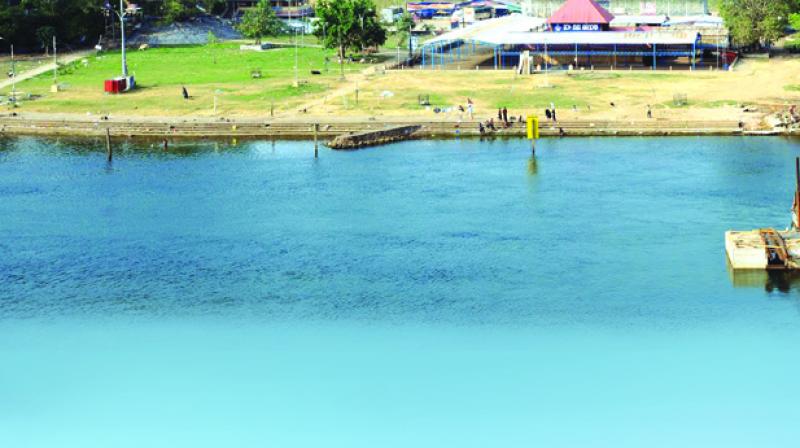Kerala: High water salinity halts pumping
High salt content in drinking water poses serious health hazards as it will affect internal organs, warn medical experts.

KOCHI: Pumping from the Kerala Water Authority’s Aluva pump house was stopped due to the high density of saline content in the river’s water. On Monday, the salinity level near the KWA intake well in Periyar reached a very high level of 1000 ppm (parts per million) after which pumping was stopped. The Authority resumed pumping later after the salt content reduced. “During high tide, the highly saline water reached the intake well by 2.45 PM leading to pumping being stopped. Later, the salinity level started receding and pumping was partially resumed when the level reduced to 175 PPM. Pumping will be again affected if salt content escalates beyond 200 ppm, as the pump house has no facility to treat saline water,” said a KWA engineer at the pumping station.
The district administration instructed the release of additional water from Bhoothathankettu dam which helped to ease the salinity level. If the problem of high salinity persists, water supply to the city would be disrupted in the coming days, KWA authorities said. More than 265 MLD (million litres per day) treated water is pumped from the Kerala Water Authority’s Aluva treatment plant to the Greater Cochin area and suburban panchayats catering to lakhs of people. High salt content in drinking water poses serious health hazards as it will affect internal organs, warn medical experts.
Unlike previous years, the phenomenon of saline water intrusion to the river started very early due to poor monsoon and low water level. The delay in constructing the temporary sand bund at Purappallikkavu also accelerated the brackish water intrusion from Vembanad backwaters. As the construction of a temporary sand bund is yet to be completed, salinity intrusion will continue. Potable water supply through tankers in Corporation areas will also be affected as tanker lorries operating in the city draw water from the Aluva pump house.
Early intrusion points to climate change
The intrusion of high salinity into the upstream of River Periyar which disrupted drinking water supply to greater Kochi areas can be termed as solid evidence of climate change. According to environmental experts, the scanty and changing monsoon pattern has resulted in the early occurrence of saline water intrusion into River Periyar, an annual phenomenon that happens during December and January when the tide is high.
“For the last few years, saline water is reaching the river’s upstream very early, even by October end thanks to the changing rain pattern. The monsoon flushing of Vembanad Lake is a major factor that prevents intrusion of salinity to the Periyar. With a sharp decrease in monsoon, the rush of saline water into the river is high for the last couple of years,” said Purushan Eloor, research coordinator of Periyar Malineekarana Virudha Samithi. In the last week of November in 2012, the salinity level near the KWA intake well had reached a very high level of more than 2000 ppm.
“In December and January, the tide is high and therefore there is a reverse thrust of water, with the polluted and saline water reaching upstream where the KWA’s pump house is located. Any pollution in the Periyar will directly affect the city and its suburbs as it is the main source of drinking water for the area.” The delay in construction of a temporary sand bund at Purapallikkavu, the northern boundary of the river, also results in saline water intrusion.
“Considering the scanty monsoon and low water level in the river, the Irrigation Department should have completed bund construction by October ,” he said. Meanwhile, there has been a growing demand to set up a permanent mechanism to prevent saline water intrusion as Periyar is the only drinking water source for greater Kochi. There has been increased demand for installing facilities at the KWA Aluva pump house to treat water with high saline density as the issue is set to worsen in the coming years.
Funds allotted for regulator cum bridge
The state government has allocated funds to complete the construction of Purappallikavu regulator cum bridge in Karumalloor panchayat which has been stuck for several months. Once the regulator cum bridge is completed, the perennial issue of saline water intrusion to River Periyar during summer can be resolved. The Rs 100 crore bridge will help the Irrigation Department save a huge amount of money spent on constructing a temporary bund every year. The building of the bridge came to a standstill after the contractor stopped citing unavailability of funds.
Of the Rs 100 crore, the Public Works Department is providing Rs 68 lakh while the remaining money is shared by the Water Resources Department and NABARD. The bridge from Purappillikkavu to Kunnukara will resolve drinking water scarcity in several panchayats and municipalities. The project will also help irrigation in vast areas of agricultural land including 300 acres of paddy field in the district. With the allocation of funds, the contractor has restarted the construction of the shutters of the bridge. Saline water intrusion is a grave issue, because it will damage crops, as thousands of farmers in the area are dependent on irrigation from river Periyar.

